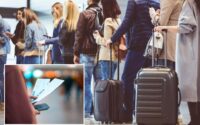Experts reveal why you should always put on your oxygen mask before your kid’s on an airplane
You should know the safety spiel well by now – “In the event of emergency, put your oxygen mask on first.”
But have you ever wondered why the cabin crew is so careful to hammer this information into our brains and what may happen if you didn’t follow the rule?
Just as a plane is about to takeoff, flight attendants go through a thorough safety procedure where they also highlight the need to “secure your own mask, before helping others.”
Most of us are thinking, “What about the kids? Surely the 30 seconds it takes to put on their mask isn’t going to cause a massive problem.”
Wrong.
“Bluntly, airlines want parents to fix their oxygen masks first because they don’t want a plane full of unconscious parents and unsupervised toddlers,” Angus Kidman travel expert at Finder told news.com.au.
“By getting parents to put on their masks first, airlines ensure that they can then help with fitting masks for their kids.”

Kidman said masks can be a confusing and stressful experience, especially for younger children, and the crew will be too busy with other crucial safety tasks to help.
“At higher altitudes, there might only be 60 seconds between when the mask drops and when your mental capacity is reduced because of lack of oxygen and it becomes challenging to help others,” he said.
Kidman said actual oxygen mask deployments on flights are rare, but they do happen.
“For instance, in July this year, an Air India flight from Dubai to Kochi deployed its masks after a rapid loss of air pressure in the cabin,” he said.
According to India’s leading aviation publication, Aviation A2Z, the 258 passengers on-board the Dreamliner flight were diverted to Mumbai after the captain reported a “loss of pressure.”

The air at high altitudes is thin, and oxygen levels very low, so aircraft have clever systems in place to keep cabin pressure at a level equivalent to an altitude of around 1524 to 2438 meters.
So, a loss of pressure can therefore be a significant issue – and potentially dangerous.
This is why in the event of an emergency it is important to fit your oxygen mask first, because by helping others first, or ignoring the mask altogether, a person will begin to lose his or her ability to recognize faces and shapes, and eventually pass out.
Hence, the flight-safety demo that has been drilled into the minds of every passenger over and over – to take care of their own mask right away.
In a YouTube clip that has amassed 11 million views, US engineer Destin Sandlin entered a special chamber with an astronaut to find out what happens if you don’t put on your mask.
The demonstration was performed at 25,000 feet, however, most airliners travel at 35,000 feet.

After a few minutes, Destin starts to lose brain function and can’t identify basic shapes.
He starts to suffer from hypoxia – a state in which oxygen is not available in sufficient amounts at the tissue level to maintain adequate homeostasis.
Soon, he can’t even speak or put his mask on, and someone must step in and put it on for him. Once his mask was fitted, Destin was able to properly identify shapes again.
“Look at that. See? That right there proves how much he’s already gone from hypoxia to back to feeling 100 percent,” Randy Woodard, Aerospace Physiology specialist says in the clip.
“So this is really important,” Destin says. “This is why on aircraft they tell you to put your oxygen mask on before you help younger children.
“Because then you’re able to have the mental awareness to be able to save yourself and save others.”
Randy said if a passenger was reaching over to put a mask on a child, they may end up passing out from the lack of oxygen.
“I can tell’ you right now, had Susan not been in there with you and gotten your mask back on. We say it, ‘You would have died,’ you really would have.”
Destin shared a chart that showed way less oxygen at 35,000 feet.
“You literally have seconds of useful consciousness at that altitude,” he said. “You can go from a normally rational person to someone so helpless you can’t even save yourself if your life depends on it.”


